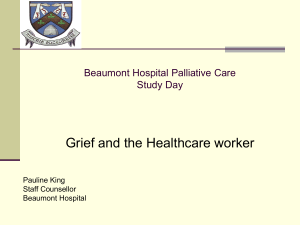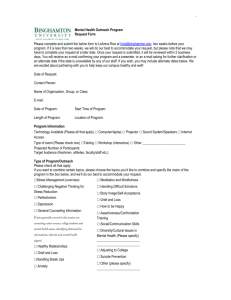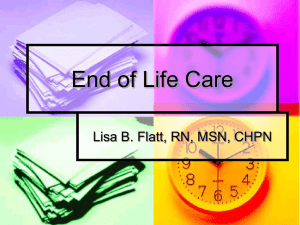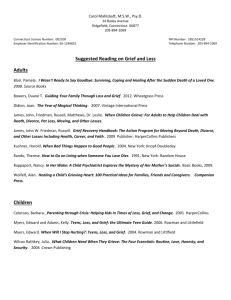Grief-and-Healingsept2013-v12tracked-2
advertisement
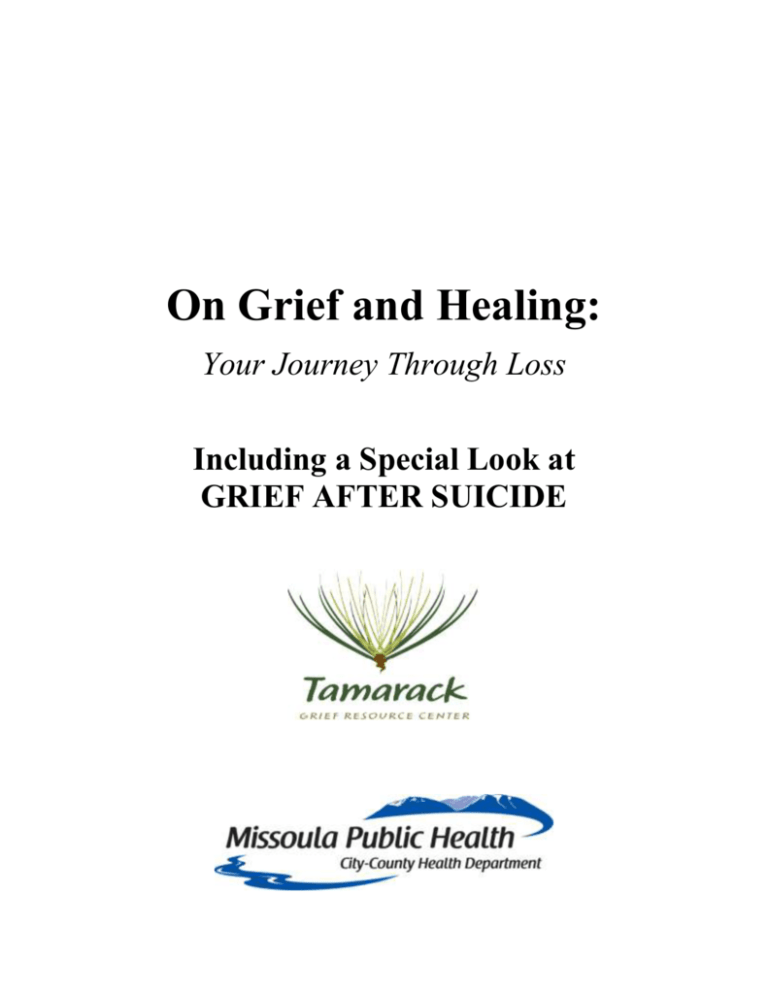
On Grief and Healing: Your Journey Through Loss Including a Special Look at GRIEF AFTER SUICIDE Table of Contents What is Grief? …………………………………………….…………… 3 Why Grieve? ………………………………….……………………….. 5 Tasks of Grief ………………………………….……………………… 5 What to Expect …………………………………………..……………. 7 Healing Grief ………………………………………..……………...... 11 Supporting Grieving Kids …………………………………….……… 12 Supporting a Grieving Neighbor or Colleague ………………………. 15 Supporting Grieving Family Members and Friends………………….. 16 Traumatic Grief Responses ……………………….............................. 17 Grief After Suicide ………………………………............................... 18 Suicide …………………………...……………………………... 20 Suicide Warning Signs …………………………………………. 20 What To Do …………………………………………………….. 20 Grief Resources ………………………………………………………. 21 This book was created by: Tina Barrett, Julie Ballew and Molly Pickett of Tamarack Grief Resource Center with guidance and support from the Suicide Prevention and Support Network including Chaplain Chuck Lee, Missoula County Sheriff’s Department; the Suicide Prevention Program / Missoula City-County Health Department; and Rusty Dague, Survivor / Community Liaison. 2 This book is likely in your hands because you have experienced the death of someone close to you or because you are supporting someone who has. Your world has forever changed. The thoughts and tips in this book are those of others who have journeyed with grief. Our hope is to be able to offer you bits of comfort and guidance as you face life after loss. The following pages highlight some ideas about grief, coping, trauma, and suicide as well as offer resources that may help your healing process. WHAT IS GRIEF? Grief is a natural yet complex response to loss of any kind. These losses may include: Death of someone close to you Family relationships Financial security A home and/or a community Familiar routines Friends Support Faith Feelings of security or safety Peace of mind Hopes and dreams Death of a pet The death of a loved one is perhaps one of the most devastating losses. Grief following a death is also referred to as bereavement. Grief is a complicated process guided by our past, our religion, our socioeconomic situation, our physical health and the cause of the loss. Our role models, our personality, and our culture all influence how we grieve. Love, anger, fear, frustration, loneliness, guilt and relief may all 3 be part of grief. Expressing your grief is not a sign of weakness. As we love deeply - we grieve deeply. We also grieve the disruption of life as we know it including loss of hopes, plans and dreams. Grief is a long process, full of ups and downs. It often takes longer than we wish it did, and longer than society usually allows. Try to be patient with yourself. Each person’s grief is unique and no two people grieve in the same way. Some people cry and some do not. Some want to sift through photos and share stories, while for others that is not helpful. Some put energy into work and “getting things done” while others find it hard to motivate. There is no “right” way to grieve. The challenge is giving yourself and your loved ones permission to each grieve in your own way. Unfortunately, some folks are not comfortable with grief. Some friends and family may feel uncomfortable around you. It is not uncommon for them to want to help in some way, yet also feel that they do not know how. They may feel unsure of what to say or do, and could even invalidate your experience of grief unintentionally. While you may feel pressure to present as independent and strong, it can be helpful to let others know what you need. Help those you trust be supportive by being as clear as you can about your experiences and needs. It also may be helpful to let your support systems know whether or not you want to talk about your loved one. Try to be specific about ways people can support you. Some examples may be: “It would be helpful if you mowed my lawn once or twice,” “I would love it if you could watch the kids for a few hours,” or “I would like to go to the grave but not alone, will you come?” 4 WHY GRIEVE? Although it is natural, grief is tricky. Grief can zap your motivation making it hard to function, ultimately impacting your quality of life. You deserve to honor your loss and to reinvest in life. You can do this by grieving your loss in your way. Though grief is not something you will ever get “over,” it is possible to honor the loss and life of your loved one, and ultimately to re-experience hope and meaning in life. TASKS OF GRIEF: It would be nice if there was a clear guide or map for how to navigate grief. Unfortunately, grief is different for every person and for each loss. Although there are no clear steps or stages, there are some general tasks that most people find important as they journey with loss. 1. Accept the reality of the loss. Your first reactions to loss may be shock and disbelief. These are normal responses that help us cope with the impact. Accepting the reality of the loss does not mean that the loss is acceptable. It means being able to acknowledge the loss. 2. Experience the emotions. Each person has their own response to loss. Your experience may or may not include some degree of sadness, anger, guilt, regret, fear, relief, despair, and loneliness. It is also common for people to describe feeling “numb” following the death of someone significant in their life. 3. Shift the relationship. A death ends a life, not a relationship. We know how to love or relate to those we hold dear to us as we move through life, even if they are not always physically present with us. Our task is to explore how to honor that relationship with someone who is no 5 longer alive, and to find ways to gain strength and move through our days. This task encourages us to adjust to new roles and explore how we can create ways to honor the loss, and still experience connection. 4. Adjust to a new role and new views. The death of someone close to us rocks our everyday world. The task is to work toward creating a new normal. This may involve creating new routines, acquiring new skills, and finding new sources of support. 5. Re-engage in life. Given that this significant loss has occurred, another task is to figure out who we want to be and how to live that out. Part of grief is also continuing with life. This task highlights the value of investing time and energy in activities that are important to you. You may spend time at work or school, or doing things that make you feel healthy and alive. These tasks are not in any order. As days and years pass, the feelings will become less intense. While the loss is always there, memories can shift to bring a bittersweet smile to your face as you recall relationships you hold dear. May you surround yourself with supportive others throughout your journey. 6 WHAT TO EXPECT Grief in the Body: Following loss, it is common to feel body aches and pains, as well as to be tired. You may even feel hungry all the time or find you have no appetite. Many people describe stomach trouble, headaches, chest pains and tightness in the throat or chest. Tips: Work on getting adequate sleep. Maintain a balanced diet. Drink plenty of water. Avoid the use of drugs or excessive alcohol. Incorporate exercise into your daily routine. Grief Behaviors: You may find yourself crying, having difficulty sleeping (or wanting to sleep all the time), eating differently, and/or experiencing sexual difficulties following a loss. You may find you are short on energy or you may find it hard to concentrate or make decisions. Tips: Take time to make decisions. Not many things need to be decided today. Ask for help when making life changes. Be patient with yourself. Allow your routines to be different. Grief Emotions: Many different emotions can arise as you grieve, or you may find you do not feel much at all. Sadness, loneliness, anger, guilt, relief, despair, and confusion are all common. Anger may be directed toward yourself, your spouse, your children, a higher power, God, or others. Real or imagined guilt surrounding loss is a normal part of grief. Sometimes, guilt is portrayed through thoughts like: “If only I would have” or “I should have.” Tips: Allow yourself to be where you are emotionally. As long as you are not hurting yourself or others, it is probably okay. 7 Express your feelings if that is right for you. Work with someone you trust, such as a grief specialist, chaplain, counselor or clergy to work through guilt and other emotions. Psychological Grief: There are many ways that our minds respond to the death of a loved one. You may feel preoccupied with your loved one or the details surrounding the death. You may “see” or “sense” your loved one’s presence. Your thoughts may not be logical. You may experience memory loss. You may experience dreams, daydreams, and/or hallucinations about your loved one. You may find yourself turning the deceased into a hero, or a perfect person. You may feel depressed and wonder if you have anything left to live for; or you may imagine joining your loved one in order to escape the pain you are feeling. Tips: Be honest with yourself and others about your experiences/feelings. It might help to talk with someone about your loved one. Seek help from an empathic friend, family member, hospice volunteer, physician, spiritual leader or professional counselor. Spiritual Grief: Healing involves feeling hopeful and finding meaning in life. Hope and faith may seem distant for a while following your loss. If you follow a religious tradition, you may find comfort in the beliefs and rituals that your religion offers. On the other hand, you may discover that past belief systems and spiritual activities are no longer offering you the faith or guidance that you experienced before your loss. 8 Tips: Try to surround yourself with safe supports who offer you strength throughout your healing. Some people want to share and some people do not. Either way is okay. Rituals and traditions may help you find meaning within your spiritual beliefs. If you are questioning your faith in the wake of the loss, talk to a trusted friend, grief specialist, clergy member or others in your community. Create time to participate in activities that help you feel stable. Examples include: meditation, prayer, going to church, exercise, and being outdoors. Social Grief: Friendships and support systems can shuffle during times of grief. You may find that friends become either more or less supportive. Family relationships also experience shifting roles. Sometimes unexpected acquaintances or neighbors can be very helpful and understanding. People who have experienced a similar loss can often provide valuable understanding. It may be necessary to “set the rules” and let those around you know what works best for you. You may find yourself being more sensitive to people, comments, and situations around you. You may find that you want people around you or you may want to pull away from family and friends. Tips: There may be benefits to continuing existing routines or patterns. Allow yourself to accept the kindness of others. Interact socially with others and make new friends when it feels right for you. Give yourself permission to join social activities on your terms—when, and only when, it works for you. Feel free to set limits and attend a function or activity for a very limited amount of time with those who you wish to be with. 9 Deliberately surround yourself with others who offer comfort and strength and allow yourself space from those who do not. Participate in grief support groups. This is a place that you can find connection and other understanding people experiencing loss. Financial Impacts of Grief: A death often leads to financial stress as medical and funeral expenses pile up. The death of someone who brought income into the home, or helped care for the children can lead to significant challenges. In addition, your own productivity may or may not be temporarily decreased. Tips: Accept help without strings attached. You deserve help with meals, expenses, and family savings if it is offered. Make financial decisions with someone you trust or a financial advisor. Daily Logistics: Managing the mail, phone calls, and voice messages may seem overwhelming, especially as messages come in for your loved one. This may be both very painful and hard to handle in the beginning. You may need to change names on checks, personal voicemail recordings, as well as mailing addresses. This does not have to happen immediately, and you might want to take time deciding how you want to address these things. This can be particularly challenging if you have not been the one in this role in the past. Tips: Again seek help and advice from those surrounding you. Allow yourself to simplify and decide what absolutely has to happen and what can wait. Let others help with logistics, making sure that you get to decide how long you would like a certain voice on your voice mail or name on your checks. 10 HEALING GRIEF 1. Give Yourself Permission to Have an Emotional Response. You do not have to present yourself as brave. It is okay to cry. This also applies to men…strong men can and do cry. 2. Give Yourself Permission to Grieve in Your Own Way. Share your grief with a trusted support if that is what feels right for you. Again, grief is a personal and individual process and what feels right for you may not be a fit for someone else. 3. Keep Busy. Do purposeful work that engages your mind. Carve out time to honor the loss of your loved one. 4. Take Care of Yourself. Bereavement can impact your health. Currently you may feel you do not care. However, it is important to continue caring for yourself. 5. Eat Well. Your body needs nourishment as you deal with the emotionally and physically taxing work of grief. A vitamin supplement may be helpful in providing the nutrients you need if your appetite has decreased or intake is not sufficient. 6. Exercise Regularly. Exercising can cause changes in your brain that can decrease depression. It may also allow for better sleep patterns. Physical activity is recommended 30-45 minutes per day, 3-5 days per week. Something as simple as taking a walk can be helpful. 7. Process Through Feelings of Guilt. Guilt can be a heavy load to carry. Whether it is real guilt or imagined, exploring this with a professional may be beneficial. 8. Accept Your Understanding of the Death. Accepting your loss is a process. It is okay right now to be where you are in your experience. As you move through your grief, your level of acceptance may change. 9. Join Support Groups. You may notice a shift in friendships with old friends moving away from you and new ones entering in. It is important to find a group of friends who have also experienced loss. This may be through a bereavement group or via other connections. 11 10. Associate with Old Friends. Though it may be difficult, continuing connection with old friends can be helpful while you grieve. SUPPORTING GRIEVING KIDS Children grieve differently than adults. The following are several markers of childhood grief: 1. Grief Bursts: Children often move between emotions very quickly. They may shift from sad to happy to demanding to silly within a short period of time. They may present as very matter-offact as they try to make sense of what has happened, or may even seem unaffected. 2. Importance of Play: Kids make sense of their world and find meaning through play. Give them opportunities for expression that does not involve words, but rather imaginative play, drawing, movement, and games. 3. Youth Development: Young people quite simply do not understand death. Instead, as they grow, they become more aware of what death means. As they reach new levels of understanding throughout childhood and adolescence, they re-grieve. While there are no set ages and stages, the following outlines common grief responses and highlights what you as the adult can do to help your child grieve. Ages: 0-1 years Common Responses: Infants live through their senses, and long for the smell, feel or sight of someone close to them. Babies who grieve may become agitated, thrash, cry or may become sick. Tips: Provide lots of physical contact. 12 Keep familiar routines (food, sleep, etc.). Provide reassurance to your child. If you feel frustrated or overwhelmed, find someone who can calmly hold them and care for them to give you a break. Ages: 2-5 years Common Responses: Young children hear that someone died, however, they may think that death can be reversed or that the person may return. A child may not directly understand cause and effect, which can lead to confusion and fears. For instance, if grandma died in her sleep, a child may be concerned about sleeping. Nightmares and changes in sleep and eating routines are common at this age. Themes of death may become more common in their play. Tips: Be very simple and clear about the death. Allow for repetitive questioning and continue to answer these questions. Maintain routines and structure. Allow for wave-like spurts of grief. Ages: 6-10 years Common Responses: Children this age often show their grief through their bodies and play. They are beginning to understand the irreversibility of death, though are still unable to grasp the concept of “time.” They watch how adults in their lives grieve as they come up with their own responses. Tips: Answer questions honestly as the child seeks information. Clarify confused thinking around death using clear and simple language. Share your grief, and model healthy outlets for grief with your child. Find peer support groups where they can meet understanding friends. 13 Ages: 10-13 years Common Responses: The pre-adolescent swings between peer group and family for support. Emotions run high in this stage of life because of the onset of puberty. Tips: Expect the child to be in an emotional state and to work at hiding vulnerability. Expect increased emotions or anxiety. Understand that they prefer not to feel vulnerable, and help them understand what decisions and choices they have control over. Encourage physical opportunities for expression. Encourage peer support groups. Grieving is exhausting and can make it hard to function. It is not uncommon to see children this age struggle with schoolwork. Work with the teacher to modify expectations if need be. Ages: 13-19 years Common Responses: Adolescents, by nature, are striving to become independent from family. They rely heavily on their friends for support. Unfortunately, their peers often have not experienced such profound loss and may not have positive ways of coping with stress. This can result in increased risk-taking or harmful behaviors. Again, appetite, sleeping patterns, and interests may also change. Tips: Be honest with your teen. Be available. Do not attempt to take grief away. Allow for choices in expression of grief. Look for physical and emotional outlets for expression of grief (i.e. sports, dance, choir, drama, art, etc.). Encourage connections with understanding people who may not be immediate family. 14 Involving youth in Memorials: Offer to include the child in significant processes around the death. Invite them to be a part of rituals and memorials with opportunities to decline as well. Tips: Give your child choices about whether they want to attend the memorial. This is important regardless of age. Prepare your child for what to expect. Explain the language around the memorial, who will be there, what they may be wearing, how people will be acting and expectations of how they should act. Pair your child with a support figure. Trust and allow the rapid change of emotion that your child may experience at the memorial. Their ability to remain in one emotion is much shorter than that of adults. SUPPORTING A GRIEVING NEIGHBOR OR COLLEAGUE When you encounter a neighbor, colleague or friend who has lost a loved one, it can be hard to know how to respond. Here are a few suggestions of what can be helpful for those around you that are grieving. Tips: Listen. Often times it can be awkward and hard for the person grieving to talk about it; however, by offering to listen, you are offering a gift. They may not take you up on it, but if they ever do want to talk about it, they know you are there. You cannot fix it. Just be there to support. Avoid saying things that minimize the experience: o “do not feel that way” o “at least…” o “I know exactly how you feel…” 15 Ask the person grieving what they need. They may not know, but they may, and are just waiting for someone to ask or offer support. Offer specific help. Be empathic. Extend compassion and recognize the emotions of the other. A great start to empathy is just listening with genuine concern. Do not avoid the grieving person or be afraid to mention their loss. Something as simple as “I am sorry” can go a very long way. SUPPORTING GRIEVING FAMILY MEMBERS AND FRIENDS If someone in your family or friendship circle experiences a death, there are several things you can do to be supportive. Tips: Consider your personal grief history and how it influences your perspective on loss. Ask yourself if you have any biases. Be careful not to assume that your friend or family will feel exactly like you did/do. Follow the lead of the grieving person. The person experiencing the loss will give vague guidelines about how they want to express themselves. Do not be afraid to ask about their loved one or speak their name. Listen attentively. If the friend is not talking about loss, don’t assume the loss has not affected them. Reach out and show affection. Let them know they are loved and cared for. Offer presence and support as the person experiences their individual grief response. Do not be afraid to express your own feelings and memories if you have them. 16 Encourage your family or friend to share their memories and feelings. Be aware of significant dates and holidays. Be honest and loving in responding to questions or conversations. Provide opportunities with your family or friend for silence, talk, creative outlets, movement, etc. Offer help in a way that is specific (i.e. “can I walk the dog, help with shopping,” etc.) Allow time to grieve, then more time. Provide resources for support groups. Allow and encourage “search for meaning” questions. It is okay not to have answers. TRAUMATIC GRIEF RESPONSES Following trauma or traumatic loss, a child or adult may feel: Intense fear A sense of helplessness Increased arousal Re-experiencing or reliving the situation Trouble falling or staying asleep Trouble with concentration Anger outbursts Often times, grief and trauma responses can have overlapping qualities. It is not uncommon for grief symptoms to resemble trauma in many ways. Many individuals, especially children, can experience traumatic responses regardless of the cause of death. 17 GRIEF AFTER SUICIDE These suggestions are from the American Foundation for Suicide Prevention (AFSP) website, www.afsp.org: 1. Know you can survive. You may not think so, but you can. 2. Struggle with “why” it happened until you no longer need to know “why,” or until you are satisfied with partial answers. 3. Know you may feel overwhelmed by the intensity of your feelings, but all your feelings are normal. 4. Anger, guilt, confusion, forgetfulness are common responses. You are not crazy — you are in mourning. 5. Be aware you may feel appropriate anger at the person, at the world, at God, at yourself. It is okay to express it. 6. You may feel guilty for what you think you did or did not do. Guilt can turn into regret through forgiveness. 7. Having suicidal thoughts is common. It does not mean that you will act on those thoughts. 8. Remember to take one moment or one day at a time. 9. Find a good listener with whom to share. Call someone if you need to talk. 10. Do not be afraid to cry. Tears are healing. 11. Give yourself time to heal. 12. Remember, the choice was not yours. No one is the sole influence in another’s life. 13. Expect setbacks. If emotions return like a tidal wave, you may only be experiencing a remnant of grief, an unfinished piece. 18 14. Try to put off major decisions. 15. Give yourself permission to get professional help. 16. Be aware of the pain of your family and friends. 17. Be patient with yourself and with others who may not understand. 18. Set your own limits and learn to say no. Steer clear of people who want to tell you what or how to feel. 19. Know that there are support groups that can be helpful. If you cannot find one, ask a professional to help start one. 20. Call on your personal faith to help you through. 21. It is common to experience physical reactions to your grief, such as headaches, loss of appetite, inability to sleep. 22. The willingness to laugh with others and at yourself is healing. 23. Wear out all your questions, anger, guilt or other feelings until you can let them go. Letting go does not mean forgetting. 24. Know that you will never be the same again, but you can survive and even go beyond just surviving. 19 SUICIDE For every completed suicide, many lives are impacted. These survivors may experience their own thoughts of suicide and deserve support. WARNING SIGNS Suicide is not caused by one single thing. However, the following can be warning signs: Threatening to kill or hurt oneself Feeling hopeless and/or helpless Withdrawing from others Noticeable changes in moods, eating, and sleeping Lack of optimism about life and living Talking about suicide or death and dying WHAT TO DO “I care about you and want to help.” Express hope. “I am not going to leave you alone” Stay with them and remove access to guns, drugs, sharp objects, etc. “I am going to get others involved because I don’t want you to hurt yourself.” Connect them to friends, family, their mental health provider and additional support and / or contact 9-1-1. “You deserve support.” Call the National Suicide Prevention Lifeline: 1-800-273-TALK. 20 GRIEF RESOURCES Community Resources: Tamarack Grief Resource Center (TGRC): Offering grief support and education for youth and adults including groups, camps, counseling, and workshops. 516 South Orange St. Missoula, MT 59801 (406)-541-8472 www.tamarackgriefresourcecenter.org Healing Hearts for Moms: Judy Peterson (406) 549-8482 Yvonne Nelson (406) 273-6627 Montana Suicide Prevention Lifeline 1-800-273-TALK (8255) www.prc.mt.gov/suicideprevention Area Hospices Including: Aspen Hospice: 107 Bell Crossing W. Stevensville, Mt 59870 (406) 642-3010 www.aspenhospice.com Hospice of Missoula: 800 Kensington Ave. Missoula, MT 59801 (406)-543-4408 www.hospiceofmissoula.com Partners Hospice and Palliative Care Services: 2687 Palmer St., Missoula, MT 59808 (406)-327-3624, (406)728-8848 www.parntersinhomecare.org 21 Rocky Mountain Hospice: 2409 Dearborn Ave, Missoula, MT 59801 (406)-549-2766 www.rockymountianhospice.com Online Resources: Open to Hope Foundation http://www.opentohope.com The Compassionate Friends PO Box 3696, Oak Brook, IL 60522 Toll Free 877-969-0010 http://www.compassionatefriends.org GriefNet PO Box 3272,. Ann Arbor, MI 48106-3272 http://www.griefnet.org/ Grief Books: “Lessons of Loss: A Guide to Coping” by Robert A. Neimeyer “Catching Your Breath in Grief” by Thomas Attig “After Suicide Loss: Coping with Your Grief” by: Bob Baugher and Jack Jordon ”Why Do People Die? Helping Your Child Understand with Love and Illustrations” by: Cynthia MacGregor 22 Bibliography: Davidson, J. D. & Doka, K. J. (Eds.) (1999). Living with grief at work, at school, at worship. Hospice Foundation of America: Washington, DC. Trozzi, M. (1999). Talking with kids about loss. Ther Berkley Publishing Group: New York, NY. Wolfelt, A. D. (1996). Healing the bereaved child: Grief gardening, growth through grief and other touchstones for caregivers. Companion Press: Fort Collins, CO. Worden, J. W. (2008). Grief counseling and grief therapy: A handbook for the mental health practitioner, 4th Ed. Springer Publishing Co: New York, NY. Helpful Phone Numbers/Notes: __________________________________________________________ __________________________________________________________ __________________________________________________________ __________________________________________________________ __________________________________________________________ __________________________________________________________ __________________________________________________________ 23 24


